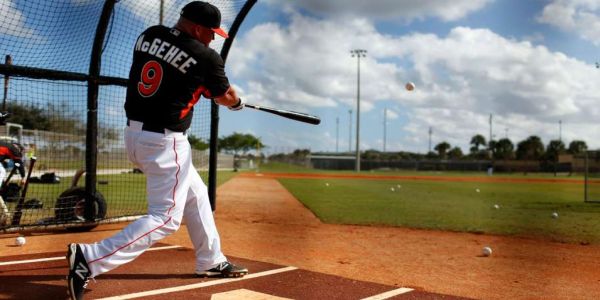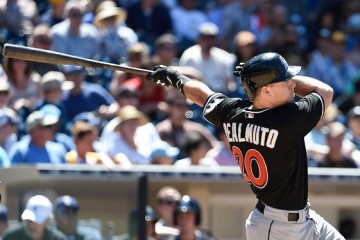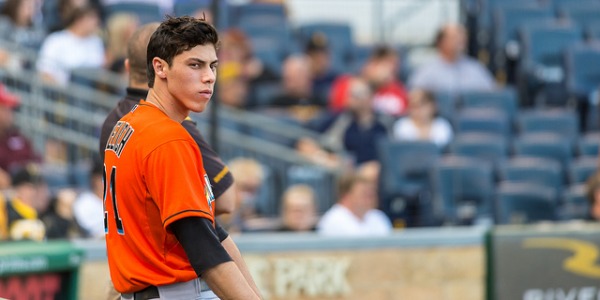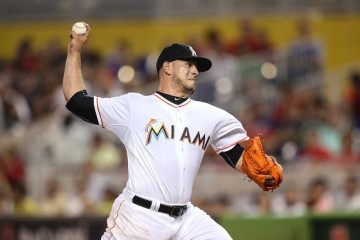2014 Fantasy Baseball: The Casey McGehee Story


Baseball is a game of failure. I hate to be so pessimistic this early on in the season, but when you think about the game itself, it is predicated on failure. After all, in what other sport could you meet your goal 30 percent of the time and be considered an all-star? However, there is always the value of looking at life on the other side of the coin. Dan Johnson could hardly be called an all-star as he may have succeeded twenty percent of the time. Yet, for one moment (in the 162nd game of the season) he came up huge.
Sabermetrics has definitely taken the game by storm, but it can’t replace the majesty and beauty of the game. We might be able to predict how often someone will be successful and in what ways they might be successful, but we can never accurately predict exactly when that player will be successful. Even though the Miami Marlins are short on proven talent, they have a group of guys that will be successful at some point. One of those guys is Casey McGehee.
A scant three years ago, he was coming off of a 100 RBI season with the Brewers. The Brewers themselves were a juggernaut at the time. They had McGehee, Ryan Braun, Prince Fielder, Rickie Weeks, and Corey Hart. The ravages of time (another boil on the butts of baseball) sent those players to the four winds of free agency, injuries, suspension, and unexplained suck. It would seem like McGehee would belong in the latter category. Then again, his 2010 campaign may have been his Roy Hobbs like experience.
The Marlins are now trying McGehee at third (and Rafael Furcal at second) because quite frankly, there was no one else. Professional athletes have often gotten a bad rap for a lack of intelligence, but most are more than aware of the temporary nature of their craft. They know that their edge can come and go in a minute and few want to waste any of those precious seasons on a team destined to win fewer than 75 games. Bad teams like the Marlins either have to overpay veterans or pick from the scrap heap.
Remember, baseball is a game about failure, but it is also about success. On a long enough timeline, the survival rate will drop to zero. Yet, on that same timeline, even the dead will rise on occasion for a glimpse of glory. Dan Johnson returned to obscurity following the final game of 2012. Yet, for that one moment he was ready to contribute and that contribution was the difference between a playoff appearance and early vacation for the Rays. Will McGehee have a Dan Johnson moment? I’m willing to bet he will have at least one, but the significance will not be attached.
|
AVG |
HR |
Runs |
RBI |
SB |
|
| 2010 |
.285 |
23 |
70 |
104 |
1 |
| 2011 |
.223 |
13 |
46 |
67 |
0 |
| 2012 |
.217 |
9 |
36 |
41 |
1 |
It should be noted that McGehee came just shy of hitting 30 home runs overseas this past season, so it wasn’t like he was sitting on the couch eating countless bags of chips. However, the stat lines from above make it seem like that fateful 2010 season was his swan song. When McGehee walks down the street, people will say “there goes Casey McGehee, he once drove in 100 runs in the big leagues.” Okay, maybe they won’t, but you get the idea.
Keep in mind that our numbers can explain why McGehee fails as often as he does, but the randomness of human performance indicates that there is always a chance that McGehee will perform well this year. He is replacing Placido Polanco and I can think of no one that would represent the polar opposite of McGehee more. Polanco constantly makes contact, but it is rarely for anything more than a single. McGehee does so less often, but it is often with more punch.
|
SO% |
BB% |
OSwing |
Contact |
BABIP |
|
| 2010 |
15.2 |
7.5 |
29.5 |
83.9 |
.306 |
| 2011 |
17.3 |
7.5 |
29.9 |
83.1 |
.249 |
| 2012 |
19.9 |
8.2 |
28.4 |
80.4 |
.248 |
Score one for the Marlins. When you take a look at the basic plate discipline numbers you see what most would call a league average player. Add in above average power and you should have an above average player. The problem is a BABIP one. We should expect a BABIP around .300 and he underperformed two seasons in a row. In a less sophisticated time, we would have simply thrown out the proverbial “I gotta hunch he’s due” and called it a day. Now, we know there are usually underlying reasons for bad batted ball numbers.
|
LD% |
GB% |
FB% |
HR/FB |
ISO |
|
| 2010 |
16.9 |
47.5 |
35.7 |
9.2 |
.179 |
| 2011 |
16.2 |
50.0 |
33.8 |
9.2 |
.123 |
| 2012 |
15.5 |
51.0 |
33.5 |
9.5 |
.142 |
Plate discipline numbers are relatively new, so many of us outside the game feel like it’s Christmas morning and Santa Claus just stuffed something new in our stocking. The problem is that while we can get a handle of what a player is swinging at and how often they make contact, not all contact is created equal. In particular, we know that batting average on line drives far exceeds batting average on ground balls and fly balls. Moreover, since some players have more power than others, those fly balls are also not created equal.
The largest area of variance though occurs in those ground balls. A Billy Hamilton would do well to have a very high percentage of ground balls. Every team has a player or two that will frequently beat out a grounder for a hit. A plotting base runner like Casey McGehee will not. He suffers with the low line drive rate and high ground ball rate. Add to that a slightly below average home runs per fly ball rate and you get a deadly cocktail as it pertains to batting average on balls in play. It should be noted that his best BABIP season came when his line drive rate was a little higher, his ground ball rate a little lower, and a few more fly balls sprinkled in.
Still, the data is moving in the wrong direction. In a data driven world, teams are increasingly able to identify the Achilles heel of every player. McGehee has definite weaknesses and a definite way to get him out routinely. Pitchers are becoming more and more successful at executing that plan. Still, even corpses rise from the dead to succeed every once in a while, so maybe just maybe Casey McGehee will do the same.





